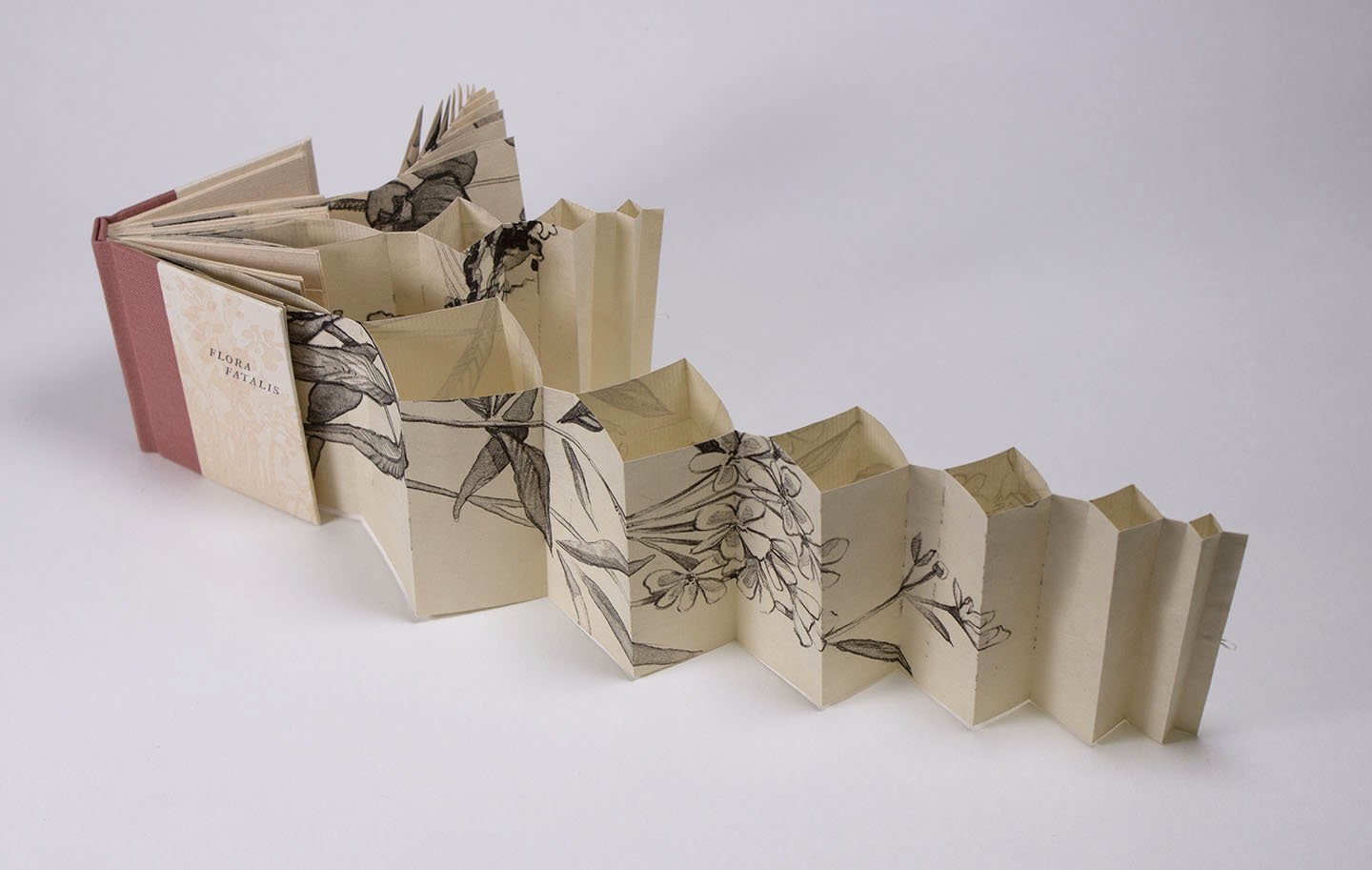Flora Fatalis was inspired by years of independent research into poisonous wildflowers common to North America. Wildflowers in a general sense are fascinating in their resiliency and durability within the natural landscape and in this book close attention was paid to wild beauties with deadly secrets.
The stories of Nightshade, Oleander, and Water Hemlock sparked the writing of three poems that accompany each botanical illustration. The text of the poems alludes to the deadly nature of these plants interjected with historical references, medical conditions and physical descriptions unique to each plant.
Flora Fatalis
Case bound book, Lithography, reduction linoleum, handset lead type
2020
3 3/8 x 2 11/16 x 5/8 inches
Edition of 10










Nightshade, often used as an undetectable poison, added to wine challis and passed from nobleman to nobleman, killing all those deemed disloyal to the crown. Likewise, the Ancient Romans often dipped arrow heads in poison made from Nightshade before going into battle. The shiny black berries are the deadliest part of the plant, containing Atropine and Solanine, chemicals that cause delirium and hallucinations. Ingesting even a handful of these berries results in fever, dilated pupils, hallucinations, and paralysis.
Oleander, was often given to a lover as a token of remembrance, and in India is placed around the deceased’s casket at funerals. This ode to everlasting love comes from tales of young love cut short by tragedy…if only one remembers not to ingest even a few of the Oleander’s seeds. Toxins are found in all parts of the plant but consuming even 4 grams of the leaves will result in nausea, dizziness, cardiac abnormalities, and death in as quickly as 15 minutes.
Water Hemlock, how often it is mistakenly identified as it’s look alike cousin, Queen Anne’s Lace (or Wild Carrot). While the latter is harmless and palatable, the ingestion of any part of the Water Hemlock plant rapidly effects the nervous system, causing a rise in heart rate, seizure, coma and as you guessed it, death.
These stories sparked the writing of three poems that accompany each botanical illustration. The text of the poems alludes to the deadly nature of these plants interjected with historical references, medical conditions and physical descriptions unique to each plant.
Upon investigation the contents of the book, delicate lithographs fold outward in fishbone fold structures. Growing and expanding the presumed dimensions of the book. Taking over the viewer’s space, much like unattended wildflowers expanding through the wild landscape. The lithographs are delicately drawn with litho crayon and touche wash. Printed in warm black ink on Kiti-kata paper. Gestured, but still identifiable.
To further highlight to the poems inside the book, a tryptic letterpress broadside series was also created. These prints are printed on Johannot. The imagery is a multi-block linoleum reduction that was editioned on a Vandercook SP-20. The tryptic series is housed in a paper folder in a deluxe edition of 10.
About the collaboration:
Master Printer, Perry Obee
The creation of the lithograph images was done in Marshall, NC at the Marshal High Studios with Collaborative Printer, Perry Obee in 2018. The artist worked with Obee for several months prior to the creation of these prints. Working in stone lithography on a print series about wildflowers. These poisonous plant prints were specifically designed to become the fishbone fold outs that are seem in the final book, Flora Fatalis.
Perry Obee is a teacher and printmaker and has an MFA in painting and completed the Tamarind Master Printer Program in 2019. He has expertise in lithography, relief, and intaglio printmaking, specializing in teaching all forms of the graphic arts including painting, printmaking, drawing, and design, as well as foundation courses and art history seminars.
